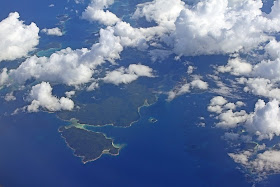The flight over gave me an opportunity to glimpse some of the islands of the Anambas archipelago. These islands sit midway between Peninsular Malaysia and Borneo, and belong to Indonesia.

Pulau Matak



These are all near Pulau Matak, not sure what they're called.

A dull day on Pulau Jemaja!

On reaching the coast south of Miri, we flew over Lambir Hills National Park.

The ever-rising tide of oil palm plantation development now laps right on its doorstep.
There was minimal time for birding during the workshop, but I did manage to walk down to the beach one evening, with pleasing results!



A juvenile Greater Sand Plover.

Food fight! An adult Greater Sand Plover chases a juvenile in an attempt to kleptoparasitize it. It's quite easy to age the birds in this photo - just look at the wingtips! Adults undergo a full moult (including the wing and tail feathers) at this time of year, while juveniles only go through a body moult and won't change their flight feathers till late next year. You can see that the front (right hand) bird has a complete set of evenly aged, fresh flight feathers, while the left hand bird is clearly in wing moult (the outermost visible primary is pale and worn, and we can see the new feather half grown growing out underneath it), so it must be an adult.

A subadult male Malaysian Plover. Even though it lacks the bright orange toned crown of an adult male, it can be identified by its variegated upperparts and the black lower border to the white collar (which also shows that it's a male).

Here's an adult male.

There were about 75 Pacific Golden Plovers, all adults in moult from breeding to non-breeding plumage.

Missing upperpart feathers reveal the pale bases of feathers underneath, causing irregular whitish patches, which can be confusing. Some of these birds even appear to have a wingbar, formed by a combination of whitish bases to the secondaries (which are usually concealed beneath the greater coverts) and pale tips to the fresh primary coverts. This motley appearance is quite typical of adult Pluvialis plovers, as well as some calidrid sandpipers, at this time of year.


Little Terns, an adult (above) and a juv. From the aggressive territorial behaviour of the adult toward me earlier in the day, I suspected that they might have bred locally.

A dark morph Pacific Reef Egret, which actually showed quite a range of maroon, brown, grey and blue tones in its dark grey plumage.

White-faced Heron (right) is an Australasian species for which there are a couple of claims in East Malaysia. Apart from the white face, other things to note, especially in flight, are the clear contrast between the pale wing coverts and dark flight feathers (on both upper and undersides of the wing) and the much thinner bill of White-faced Heron. This picture was taken in Australia in 2004.

White-breasted Woodswallows are common open country birds in Borneo, and there were a number of obliging birds behind the hotel. This one's an adult.

And here's a juvenile, distinguished by buffish tips to the wing and tail feathers.

Despite the name, they are not related to swallows, and are more akin to the butcherbirds of Australasia. White-breasted is the only species resident in Malaysia.
The woodswallow is amazing! Which cam is this frm? Flying shot looks great!
ReplyDelete